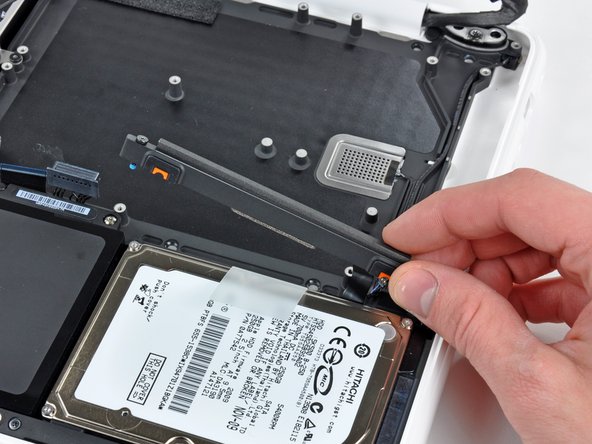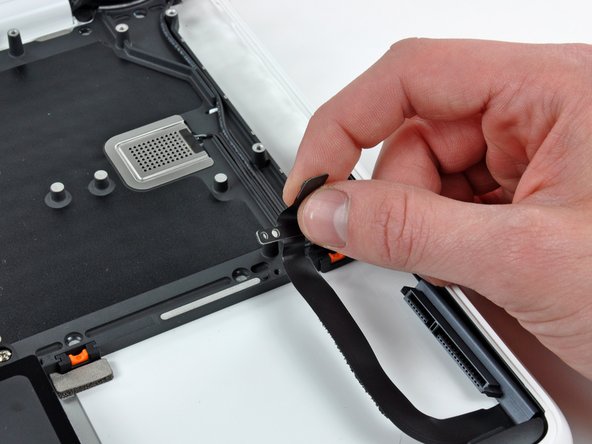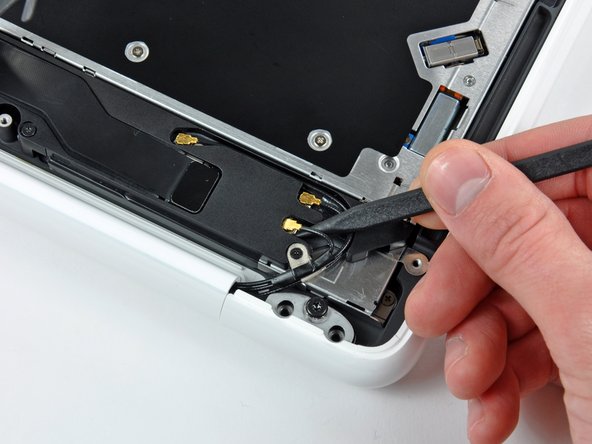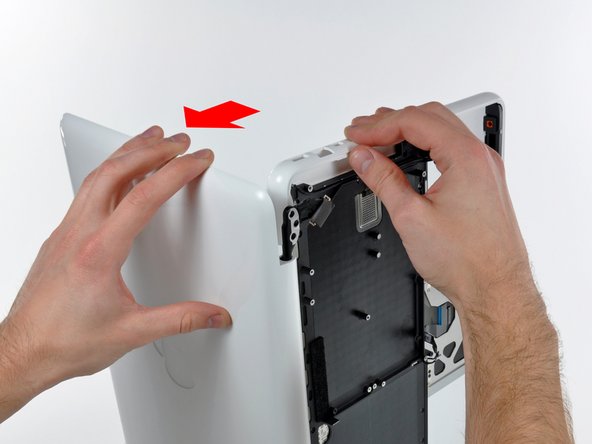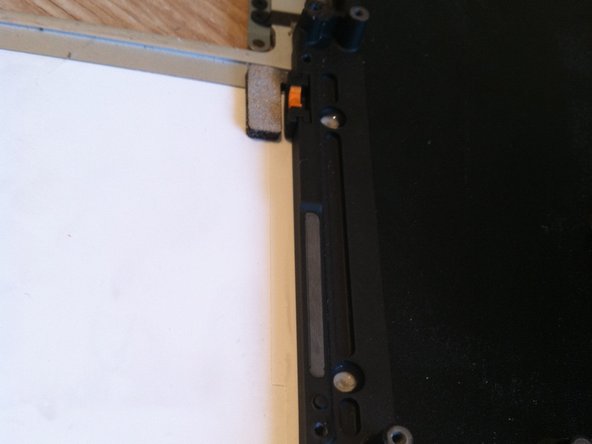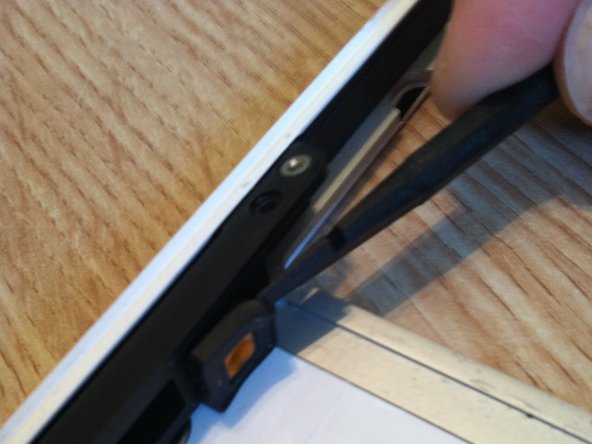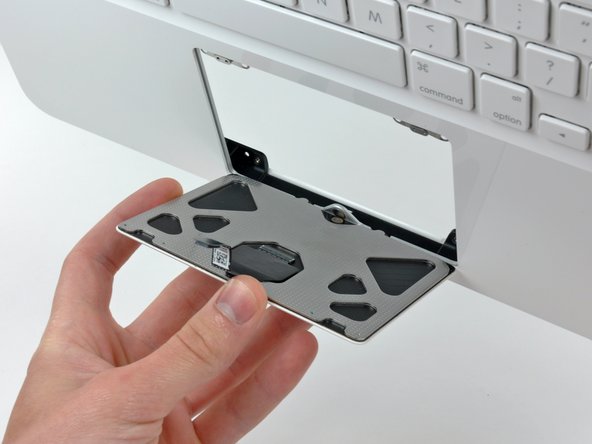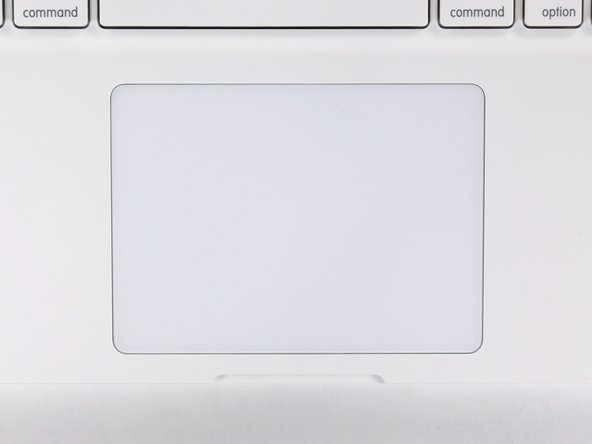Esta versión puede contener ediciones incorrectas. Cambie a la última instantánea verificada.
Qué necesitas
-
-
Retire los ocho tornillos Phillips de 4 mm que sujetan la carcasa inferior al MacBook.
-
-
-
Usar la punta plana de una spudger para levantar el conector de la batería de su enchufe en la placa lógica.
-
-
-
Remueve los siguientes tornillos del lado del disco óptico de la rejilla trasera:
-
Dos Torx T8 de 10mm
-
Dos Phillips de 5.2mm
-
-
-
Usa el lado plano de un spudger para levantar el cable plano del Airport/Bluetooth de la placa lógica.
-
-
-
-
Remueve los seis tornillos Torx T6 de 4.1 a 4.4 mm asegurando la placa lógica a la carcasa superior.
-
Remueve los dos tornillos Torx T6 de 4.1 a 4.4 mm asegurando la placa MagSafe a la carcasa posterior.
-
En algunos modelos, estos tornillos pueden ser un T7. Se cuidadoso de no rodarlos con una punta más pequeña.
-
-
-
Levanta el lado de la placa lógica opuesto a los puertos para sacarla de la carcasa superior.
-
Rota la placa lógica lejos de la carcasa superior hasta que los puertos salgan del borde moldeado en la carcasa superior.
-
Tira de la placa lógica y placa MagSafe lejos del borde de la carcasa superior como una pieza.
-
-
Este paso está sin traducir. Ayuda a traducirlo
-
Remove the two Phillips screws securing the hard drive bracket to the upper case.
-
Remove the hard drive bracket from the upper case.
-
-
Este paso está sin traducir. Ayuda a traducirlo
-
Lift the free side of the hard drive and pull it away from the side of the upper case.
-
-
Este paso está sin traducir. Ayuda a traducirlo
-
Disconnect the hard drive by pulling the hard drive cable connector away from its socket on the hard drive.
-
-
Este paso está sin traducir. Ayuda a traducirlo
-
Remove the single 3.1 mm Phillips screw securing the hard drive cable to the upper case.
-
Lift the hard drive cable out of the upper case.
-
-
Este paso está sin traducir. Ayuda a traducirlo
-
Remove two 5 mm Tri-Wing screws securing the battery to the upper case near the battery connector.
-
-
Este paso está sin traducir. Ayuda a traducirlo
-
Use the tip of a spudger to carefully peel back the finger of the warning label to reveal a hidden Tri-Wing screw.
-
Remove the 5 mm Tri-Wing screw securing the battery to the upper case.
-
-
Este paso está sin traducir. Ayuda a traducirlo
-
Remove three 3.1 mm Phillips screws securing the battery near the edge of the upper case.
-
-
Este paso está sin traducir. Ayuda a traducirlo
-
Lift the battery near its connector and remove it from the upper case.
-
-
Este paso está sin traducir. Ayuda a traducirlo
-
Use the tip of a spudger to pry the AirPort/Bluetooth antenna connectors (three total) up off the AirPort/Bluetooth board.
-
If necessary, de-route the long antenna cable from its slot in the rear speaker housing.
-
-
Este paso está sin traducir. Ayuda a traducirlo
-
Remove the single 3 mm Phillips screw securing the antenna ground straps to the rear speaker housing.
-
-
Este paso está sin traducir. Ayuda a traducirlo
-
Remove the single 2.2 mm Phillips screw inserted horizontally into the side of the optical drive.
-
-
Este paso está sin traducir. Ayuda a traducirlo
-
Remove the single 12 mm Phillips screw securing the rear speaker to the upper case.
-
-
Este paso está sin traducir. Ayuda a traducirlo
-
Remove the single 4.5 mm Phillips screw securing the inner edge of the optical drive to the upper case.
-
-
Este paso está sin traducir. Ayuda a traducirlo
-
Remove the two 2.5 mm Phillips screws securing the optical drive to the upper case near the optical drive opening.
-
-
Este paso está sin traducir. Ayuda a traducirlo
-
Lift the optical drive near its connector and pull it away from the upper case to remove it from the computer.
-
-
Este paso está sin traducir. Ayuda a traducirlo
-
Open your MacBook so the display is perpendicular to the upper case.
-
Place your opened MacBook on a table as pictured.
-
While holding the display and upper case together with your left hand, remove the remaining T8 Torx screw from the lower display bracket.
-
Before retightening the T8 Torx screws, close the display and adjust it so that the back edges of the upper case and display are aligned and the gaps at the ends of the hinge are equal.
-
-
Este paso está sin traducir. Ayuda a traducirlo
-
Remove the last remaining T8 Torx screw securing the display to the upper case.
-
-
Este paso está sin traducir. Ayuda a traducirlo
-
Grab the upper case with your right hand and rotate it slightly toward the top of the display so the upper display bracket clears the edge of the upper case.
-
Rotate the display slightly away from the upper case.
-
-
Este paso está sin traducir. Ayuda a traducirlo
-
Lift the display up and away from the upper case, minding any brackets or cables that may get caught.
-
-
Este paso está sin traducir. Ayuda a traducirlo
-
There are four orange and black rubber inserts that the hard drive sits in. One side has full circles and the other side has half circles. (The other side of the half circles are located on the hard drive bracket that was previously removed).
-
The new upper case may not have these inserts. Be sure to remove them from the old and insert into the new.
-
The inserts are easily pried out with a spudger or a flat tipped screwdriver. They are not glued in, but instead have notched sides to hold them in place.
-
-
Este paso está sin traducir. Ayuda a traducirlo
-
Remove the four 1.3 mm Phillips screws securing the upper edge of the trackpad to the upper case.
-
-
Este paso está sin traducir. Ayuda a traducirlo
-
Carefully tilt the trackpad away from the keyboard side of the upper case.
-
Pull the trackpad away from its opening in the upper case to clear the two mounting tabs on its lower edge.
-
-
Este paso está sin traducir. Ayuda a traducirlo
-
Remove the 1 mm T6 Torx set screw near the front edge of the upper case.
-
-
Este paso está sin traducir. Ayuda a traducirlo
-
Reinstall the T6 Torx set screw until it is flush with the aluminum bracket surrounding the trackpad.
-
Place the trackpad back into its void in the upper case, being sure the lower tabs are inserted underneath the keyboard side of the upper case.
-
-
Este paso está sin traducir. Ayuda a traducirlo
-
Reinstall the four silver Phillips screws securing the trackpad to its steel brackets.
-
Loosen all four silver screws about 1/16th of a turn.
-
Flip the upper case over and adjust the position of the trackpad until the gap between the trackpad and the upper case is evenly spaced around the perimeter of the trackpad.
-
Tighten the four silver screws to hold the trackpad in place.
-
-
Este paso está sin traducir. Ayuda a traducirlo
-
While repeatedly pressing the trackpad to simulate clicking, tighten the T6 Torx set screw until the trackpad no longer wiggles freely.
-
Cancelar: No complete esta guía.
197 personas más completaron esta guía.
25 comentarios
Some of the screws are extremely tight, I stripped at least 6 Phillips screws during the upper case replacement.
I used the iFixit 54 bit kit and found that the Phillips 000 bit fits the screws better than the recommended 00 bit. When loosening or tightening I use plenty of downward pressure to keep the bit from rising out of the screw head and damaging it. The torx screws are so much easier to work with and I wonder why they don't use only those.
Definitely only use unworn, appropriately sized drivers when going into any Mac or iPhone. If the driver starts to slip, stop and access the situation. That said, I have encountered many screws with damaged screw heads. I usually first try the “rubber band” trick to loosen the ruined screw. If that doesn’t work, I often resort to using a dremel tool to cut a slot in the screw (while protecting everything from the debris generated). In all cases, be careful - one slip can do a lot of damage.
Lance J -

































